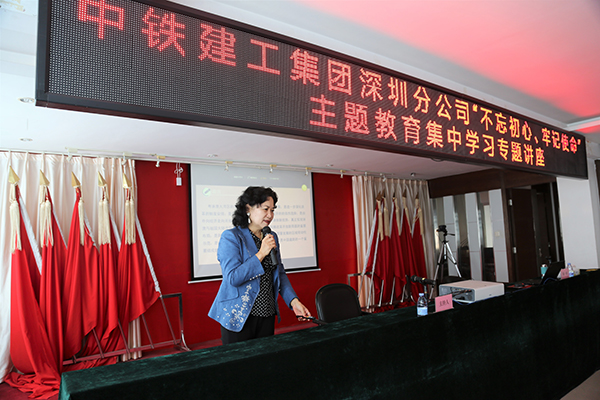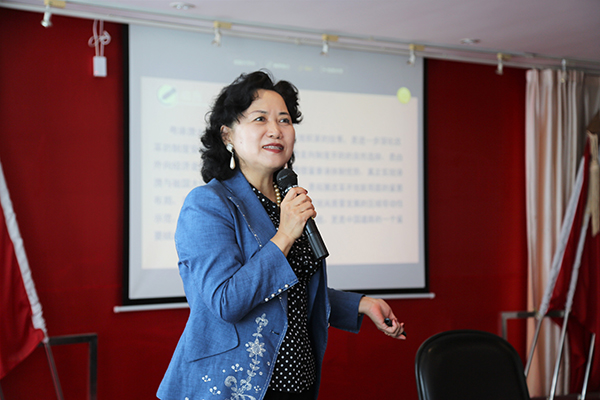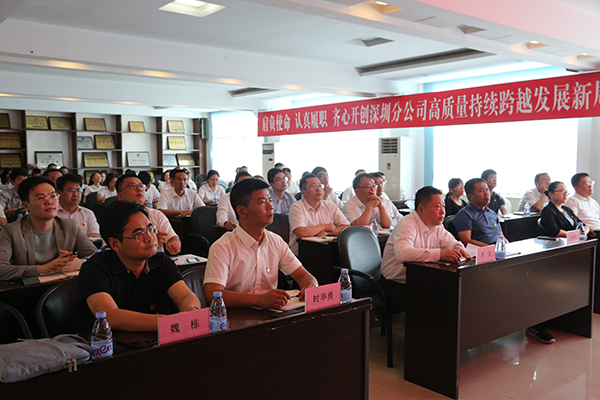On November 7, 2019, Prof. Tao Yitao delivered a lecture themed Theoretical and Practical Significance of the Plan for Guangdong-Hong Kong-Macao Greater Bay Area for the Theoretical Study Team of China Railway Construction Engineering Group (CRCEG), Shenzhen Branch. Prof. Tao is the director of the China Center for Special Economic Zone Research (CCSEZR), Shenzhen University (SZU), president of Belt and Road Research Institute of SZU and also president of the Belt and Road Research Institute (Shenzhen) for International Cooperation and Development (BRRI). Li Jia, Party Secretary of the CPC Committee of CRCEG, Shenzhen Branch, presided over the lecture. Among the 100 participants were Wang Shenfeng, President and Party Secretary of the CPC Committee of China Railway Construction Engineering Group Nuode Investment Co., Ltd., and his party, leaders of CRCEG Shenzhen Branch, Party Branch Secretary of project departments in Guangdong province, all party members of CRCEG, Shenzhen Branch. Members from the party branch of project departments at grass root level attended the lecture through videoconference.

A scene of the lecture

Li Jia, Party Secretary of CPC Committee of CRCEG, Shenzhen Branch, presides over the lecture

Photo 3 Prof. Tao is attending the lecture
Prof. Tao pointed out that the Outline Development Plan for the Guangdong-Hong Kong-Macao Greater Bay Area is an outline document guiding current and future cooperation and development of the Greater Bay Area. The Plan is proposed to achieve regional integration, the crux of which hinges on the establishment of an underlying system. To achieve both ends, we need to establish and improve a rule of law-based and open socialist market economy system that reflects the characteristics of China and conforms to international practices as well.
Prof. Tao believed that building the Greater Bay Area is not only a new attempt in furthering all-round opening-up in the new era, but also a new practice to promote the development of “One Country, Two Systems”. If the Plan is an outline document guiding current and future cooperation and development of the Greater Bay Area, the Greater Bay Area is an experimental zone intended to serve as an example for China to deepen reform, further open up on all fronts and explore comprehensive development in the future. Therefore, the construction of the Greater Bay Area is of the same milestone significance in the history of China’s reform and opening-up as the establishment of the special economic zones (SEZs) 40 years ago.
Prof. Tao said that the Greater Bay Area is characterized by institutional diversity, initial formation of the foundation of modern manufacturing industry, regional development imbalance, initial formation of the division of industry among cities and relatively strong innovation potential.
Prof. Tao further stressed that the imbalance of regional economic development among cities in the Greater Bay Area manifests itself in the following three aspects: I. On the front of basic economic data, cities in the Area have marked gaps in economic development. II. The industrial development imbalance among the cities in the Area stands out and leads to the “polarization effect”. III. On the front of other non-economic indicators and data, glaring gaps in social development are something that we can’t miss.

Prof. Tao Yitao
Prof. Tao believed that the Bay Area economy is by no means a simple concept of regional economics for China, but a growth pole that suffices to further China’s social reform and opening-up. Just like the SEZs and free trade zones, the Greater Bay Area carries the reform goal and mission of varied significance in different periods of development. It is even safe to say that the Greater Bay Area is a larger special economic zone. Four decades ago, China’s reform and opening-up started from the least developed area of the planned economy. While today, further reform starts from the most developed area of the socialist market economy. Through exploration and development, the Bay Area economy will lead further reform, and promote the move from policy opening to institutional opening and the transition from an export-led economy to an open economy.
The Greater Bay Area is located in a region where China’s market economy is relatively mature and its market is highly opened up. It not only inherited the achievements of China’s reform and opening-up in the past 40 years, but also attracted a large sum of money, element capital and institutional capital. In addition, thanks to its special geographical location, the Bay Area economic belt overlaps with the SEZ, and free trade zone. However, the challenges facing China’s Bay Area and the role it plays have noticeable country-specific characteristics as the historical process and context in which Bay Areas are formed differ for China and other countries. The formation of the Bay Area in China is related to the formation and development of the SEZs. The Bay Area is the result of the “diffusion effect” of the SEZs and will also become the growth pole that produces new “siphon effect”, so to speak, which reflects the unique path of China’s social institutional change.
Prof. Tao pointed out that, through 40 years’ reform and opening-up, China’s institutional environment and economic and social base for opening-up have changed fundamentally. China is firmly integrating into the world economic landscape and plays an increasingly prominent role in world economy. In the context of deepening reform and implementing the BRI, the Bay Area economy is not only a new opening-up mode and development path, but also a regional engine that propels China’s new round of opening-up next to the SEZs and free trade zones. Besides, the Greater Bay Area also shoulders the tasks of exploring a feasible mode for regional cooperation between countries, and an effective way for achieving mutual prosperity and development between Hong Kong, Macao and mainland China, blazing a trail in institutional change to promote the reform through opening-up, and building China into an innovative country.

The participants are listening to Prof. Tao’s lecture carefully
The participants listened to Prof. Tao’s lecture carefully before realizing that the 90-minute lecture came to an end. They all expressed that they benefited a lot from this lecture. They were looking forward to attending Prof. Tao’s lecture again. The lecture was successfully concluded in a pleasant and relaxed atmosphere.




